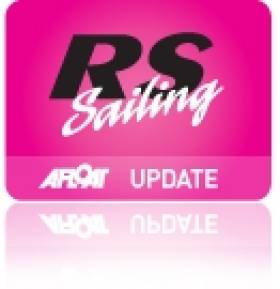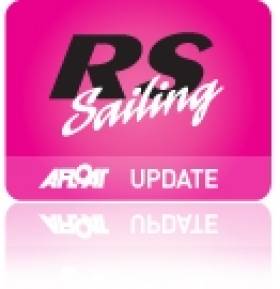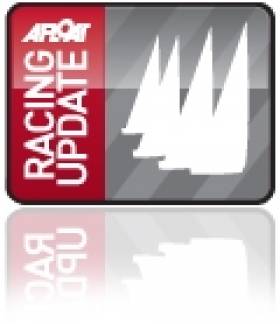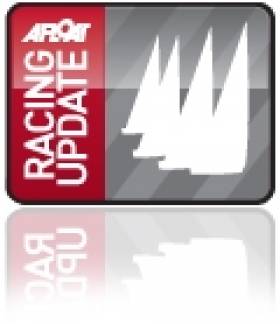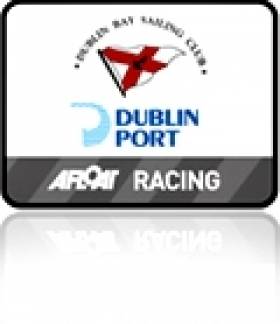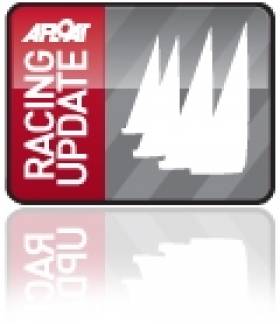Displaying items by tag: RS400
Inaugural RS400 & RS200 Sprint Trophy Preview
In the RS200 class National Champions Roy Van Maanen and Glen Reid will come into the event as favourites. However, the entry of the husband and wife team of Sean and Heather Craig of the Royal St George is sure to mix up the class status quo.
Heather Craig has already scored a very impressive 2nd at this year's RS200 Nationals, which were held at Cushendall. Sean Craig is sure to apply all of the asymmetric spinnaker skills, which he has honed in the Sb3 class to full affect on home waters.
The unassuming young Greystones pairing of Sean Cleary and Steven Tyner are the dark horses of RS200 fleet. They have been gradually climbing the ranks of the class since they made the transition up from RS Feva. They have already applied what they have learned in the Fevas at this years Nationals in Cushendall taking 3rd place overall.
In the RS 400 fleet, a strong contingent from the Royal North of Ireland Yacht Club is expected to put up a challenge to the dominance of the Greystones based National Champion Simon Herriott. The Royal North pairing of Michael McAllister and Michael Patton are sure to feature, after finishing 2nd at the Nationals. Michael McAllister is on winning form. He was part of Peter Kennedy's team, which won last weekends Sb3 Midland Championships.
Liam Donnelly and Andrew Vaughan have plenty of experience onboard and will relish the prospect of the breezy forecast.
There are also some new faces making their debut the 400 class. Wayfarer national champion Trevor Fisher has teamed up with the very capable Selina Dicker. This team could prove to be a potent combination. Selina has a wealth of asymmetric experience from her time on the UK Laser 5000 circuit.
Bernard Fitzpatrick of the Royal Cork Yacht will also make his RS400 debut. Bernard was a vital part of Mark Mansfield's 1720 European Championship winning crew and has spent the last four seasons as bowman on the international Melges 32 circuit. He is looking forward to the event as his first chance to race in the RS400.
Making his long awaited return to the RS400 class is Dave Cheyne. Dave is looking forward to combining next years RS Traveller series with his Sb3 class commitments.
Please see these Youtube videos below, which give an idea of what to expect from the RS boats. However the weather featured in the videos is unlikely to be repeated for this weekend. See if you can spot the cameo from our own Dave Cheyne in the RS400 clip.
RS400
RS200
For information on the RS Sprint Trophy e-mail [email protected]
RS Sailors Heading North to Cushendall
The 2011 RS400 and RS200 Traveller Series draws to a close this weekend with the National Championships taking place at Cushendall Co. Antrim.
Two strong fleets of over 40 boats in total are expected.
In the RS400's Simon Herriott of Greystones SC, who scored some very impressive top ten results in the 86 boat UK Nationals is going to have some notable competition with the recently crowned Irish Fireball National Champions and Cushendall locals Barry McCartin and Conor Kinsella rumoured to be entered.

Greystones SC is bringing five 'under 18' boats and more boats for sailors in their late teens /early twenties to Cushendall this weekend. The Club's hard work getting kids into fast doublehanders is bearing fruit. See more on this initiative here. Photo: Sarah Byrne
Also bolstering the fleet is multiple Laser regional champion Paul McMahon, who also has plenty of asymmetric experience from his time in the SB3 fleet. Along with the Irish contingent some of the hotly contested UK fleet may make the trip across.
In the RS200 fleet the season long battle between Greystones rivals Roy Van Maanen and Graeme Noonan is set to continue. But the Wicklow 200's may not have it all there own way, with Clive Coffey and Emily Smith sure to be contention.
Both competitors and organisers were not very optimistic on Friday evening with an ominous forecast on the Windguru web site of gusts up to a maximum of "5 knots". Thankfully even the Internet can get it wrong sometimes and everyone was pleasantly surprised when they were greeted with a steady 12 to 15 knots Southerly outside Greystones Harbour. The blue sky and sunshine providing the welcome bonus of an early sea-breeze.
With a strong tide which apparently runs South for ten hours of every twelve hour tidal cycle, judging lay-lines both up and down wind on the windward leeward courses was tricky to say the least. Though it was fair to say all crews were happy to have the tidal push for the up wind beats as it was full hiking conditions for all of day's four lap races.
In the 400 fleet Liam Donnelly took race one of the day. Greystones SC Commodore Simon Herriott suffered a breakage in race one but recovered in style to win the next two races.
In the 200 fleet Roy Van Maanen posted a perfect score card winning all three races of the day.
On day two a short postponement was followed by two light air races. Finding some pressure and managing to stay in it was the priority. This led to some dramatic place changes particularly on the down wind legs, were calling a gybe at the correct time was the difference between getting to the bottom mark in first or last place.
The sea-breeze kicked in just in time to provide plenty of excitement for the final race of the series. Amongst the 400 fleet there were four boats with the potential to take the event going into the last race. In the end Liam Donnelly and his crew, Andrew Vaughan from the Royal North prevailed in the stronger breeze taking the 400 Southerns trophy North.
In the 200's Roy Van Maanen had the luxury of discarding a 2nd to win the event comfortably. The battle for second was a little tighter with Graeme Noonan taking second place on count back from Sean Clery.
RS400 Results:
1st Liam Donnelly
2nd Simon Herriott
3rd Michael McAllister
RS200 Results:
1st Roy Van Maanen
2nd Graeme Noonan
3rd Sean Clery
Next up for the Irish RS fleet is Newcastle Co.Down. Check out www.irishrs.com for more information or to arrange test sail in an RS200 or RS400.
Herriot and Moran Win RS400 Northerns
With some clever race management on trapezoid courses and breeze well into the mid-teens, everyone enjoyed plenty of wet and wild blast reaching conditions on day one. The course layout also allowed the RS200 and RS Feva classes to share the race area without any crossovers between fleets.
Day one saw class stalwart Simon Herriot and his crew Tom Moran dominate the proceedings with three straight bullets. The picture for the chasing pack was however not so clear-cut. Only three points separated the next five boats, which left every thing to play for on day two.
Sunday brought slightly tamer conditions with a steady ten knots of chilly breeze from the North East. Another solid performance by Simon Herriot and Tom Moran earned them a 3rd and 2nd which afforded them the luxury of heading home with a race to spare and an early shower.
In the final tally, brothers Emmet Ryan/James Ryan of the Royal St George finished second, with local sailors Robin Flannigan/Phil Cully in a very close 3rd. Full results are listed below.
Next up on the four event Irish RS400 calendar is the Southern Championships which will be held at Greystones SC on the 2nd/3rd of July.
Results RS400 Irish Northerns:
1 Simon Herriot/Tom Moran: 8 points
2 Emmet Ryan/James Ryan: 14 points
3 Robin Flannigan/Phil Cully: 16 points
4 Michael McAllister/Michael Patton: 17 Points
5 Simon Hutchinson/James Waugh: 19 points
6 Liam Donnelly/Andrew Vaughan: 23 points
7 Paul Mclaughlin/Michael McKinley: 25 points
8 Rob Hastings/Rose Moore: points 40
9 Neil Strain/Katie Rebbeck: points 41
10 Arthur Mehigan/Laura Mehigan: points 46
11 Nick White/John Ferguson: points 55
12 Allan McCullough/Craig Martin: points 62
Moderate easterly winds produced a great night's sailing on Dublin Bay tonight for the second Tuesday night race of the DBSC Summer season. In the Fireball dinghy class S. Oram's unnamed boat entry won again from Louis Smyth's 'Licence to Thrill'. Gary O'Hare lead the Laser fleet and picked up the Portsmouth Yardstick (PY) win from P. Keane. Third on PY was E. Ryan's RS400 dinghy.
DUBLIN PORT Dublin Bay Sailing Club Results for 3 MAY 2011
IDRA 14 FOOT - 1. Dunmoanin (Frank Hamilton)
MERMAID - 1. Jill (P.Smith/P.Mangan), 2. Lively Lady (G O'Neill & M Hanney)
PY CLASS - 1. Gary O'Hare (Laser), 2. P Keane (Laser 1), 3. E Ryan (RS400)
CRUISERS 2 - 1. Graduate (D O'Keeffe), 2. Cor Baby (Keith Kiernan et al)
CRUISERS 3 - 1. Papytoo (M.Walsh/F.Guilfoyle), 2. Chouskikou (R.Sheehan/R.Hickey), 3. Grasshopper 2 (K & J Glynn)
CRUISERS 4 - 1. Ghrazel (Charles Pearson), 2. Maranda (Myles Kelly)
FIREBALL - 1. nn (S Oram), 2. Licence to Thrill (Louis Smyth), 3. Elevation (N.Colin/M.Casey)
GLEN - 1. Glendun (B.Denham et al), 2. Glenshesk (L.Faulkner et al), 3. Glenshane (P Hogan)
RUFFIAN 23 - 1. Icicle (C & J Murray), 2. Diane ll (Bruce Carswell), 3. Alias (D.Meeke/M.McCarthy)
Moth Dinghy Makes its Dublin Bay Sailing Club Debut
Making its debut for the first time under the club burgee was an International Moth dinghy. The ultra fast hull was airborne at just eight knots of breeze, making even the trapezing Fireballs look slow. But despite the pace the new fangled dinghy did not feature in the overall Portsmouth Yardstick (PY) results. See below.
A healthy turnout of six 'balls, urged on by the fact that the class World Championships is in Sligo in 46 days time, got some trapezing gusts and some planing waves downwind in a north-easterly breeze of 6-8 knots. S. Oram took the winning gun from Louis Smyth sailing Licence to Thrill.
Single handed Lasers boasted twice the Fireball turnout to be the biggest class racing in Scotsman's bay tonight. It's a show of strength from a class surely worthy of its own start if this kind of turnout can be maintained.
Sean Craig won the Laser race from Peter Craig but the overall PY result went to E. Ryan's RS400.
Two Dublin Bay Mermaids and disappointingly, a single IDRA 14, No.124, Squalls also competed.
DUBLIN PORT Dublin Bay Sailing Club Results for 26 APRIL 2011
FIREBALL - 1. nn (S Oram), 2. Licence to Thrill (Louis Smyth), 3. Incubus (C Power/M Barry)
MERMAID - 1. Lively Lady (G O'Neill & M Hanney), 2. Jill (P.Smith/P.Mangan)
PY CLASS - 1. E Ryan (RS400), 2. Sean Craig (Laser), 3. Peter Craig (Laser)
BENETEAU 31.7 - 1. Extreme Reality (P.McSwiney/E.O'Rafferty), 2. Magic (D.O'Sullivan/D.Espey)
BENETEAU 31.7 - 1. Magic (D.O'Sullivan/D.Espey), 2. Extreme Reality (P.McSwiney/E.O'Rafferty)
CRUISERS 2 - 1. Cor Baby (Keith Kiernan et al), 2. Red Rhum (J Nicholson), 3. Free Spirit (John O'Reilly)
CRUISERS 3 - 1. Grasshopper 2 (K & J Glynn), 2. Pamafe (Michael Costello), 3. Papytoo (M.Walsh/F.Guilfoyle)
CRUISERS 4 - 1. Maranda (Myles Kelly), 2. Ghrazel (Charles Pearson), 3. Artemis (J.Giles)
RUFFIAN 23 - 1. Diane ll (Bruce Carswell), 2. Icicle (C & J Murray), 3. Alias (D.Meeke/M.McCarthy)
SIGMA 33 - 1. Rupert (R.Lovegrove/P.Varian), 2. Pippa lV (G.Kinsman/K.Blake/M.O'Brien)
SQUIB - 1. Tais (Michael O'Connell), 2. Periguin (N.Coakley/J.Redahan)
More DBSC News here.
Greystones Sailors Lead RS400s in Cushendall
There were 23 high performance boats starting today's races – 16 in the RS 400 class and seven RS 200s. Of the fleet, large numbers travelled from Greystones (Co Wicklow) and Royal North (Cultra), with boats also coming from the National Yacht Club (Dún Laoghaire), Strangford Lough and Ballyholme. Six local Cushendall boats also started.
The fast, light-weight sailing dinghies have a crew of two.


























